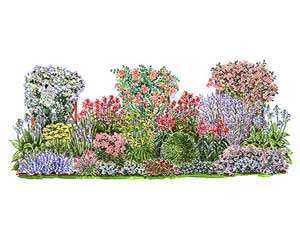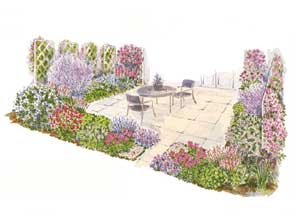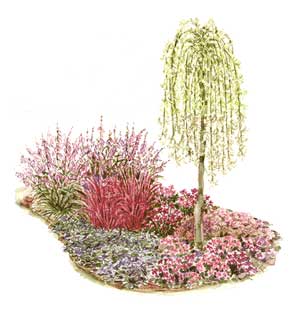Perennial Corner - If flowers are your thing, this is the garden for you. Seven high-performance perennials will give you plenty of flowers, all summer long and into fall. Tuck the garden into a corner or plop it in the middle of the lawn-these plants will put on a show wherever they get six hours or more of sunlight daily. If you want to add some extra flowers in early spring, be sure to include a variety of your favorite bulbs.
|
 |
| Perennial Corner |
|
|
 |
| Full Sun Garden |
|
| Full Sun Garden - This plan features easy-to-grow, reliable plants that require minimal care. There will be something happening in the garden throughout the growing season. In spring, Siberian iris starts the parade. Summer is anchored by the cheerful flowers of purple coneflower and shasta daisy (among others). The pink flowers of stonecrop complete the show in fall. This is a good starting plan for anyone interested in perennials.
|
Shade Garden - This low-maintenance, foolproof shade garden is attractive in three seasons, but particularly throughout late winter and spring. Witchhazel and astilbe light up the early season with their cheerful blooms. The striking leaves of hosta and Solomon's seal ensure that the garden is attractive even when the flowers aren't in bloom. Shade gardens prefer organic soils, just like Mother Nature's woodland soils. Keep this one moist but well drained for best plant health.
|
 |
| Shade Garden |
|
|
 |
| Corner Grass Garden |
|
| Corner Grass Garden - Gardeners are just beginning to discover ornamental grasses and their majestic contribution to home landscapes. These lush fountains of foliage are lovely in spring and summer, but they're nothing short of spectacular in fall, when their feathery flower heads sway in the breeze. The buff-colored plumes endure into winter, too, keeping the garden attractive when all else has gone dormant. For contrast, we've added a couple flowering perennials and some optional spring-flowering bulbs to the design. Plant in full sun.
|
Fragrant Garden - In addition to its sweetly perfumed blossoms -- lilies, dianthus, phlox, nicotiana, and others -- this garden includes plants such as Russian sage and catmint, whose aromatic foliage releases scent only when touched. A succession of fragrances spans the growing season, from irises and candytuft in spring to sweet autumn clematis. Three 4-foot-wide trellises are optional; they accommodate vining plants and serve as backdrop. This garden could be placed next to a patio, against a fence, at the side of the house, or along a property line. Make sure there is a comfortable chair nearby, where you can take in the intoxicating aromas. These perennials, annuals, and vines will bloom best in a sunny exposure.
|
 |
| Fragrant Garden |
|
|
 |
| Butterfly Garden |
|
| Butterfly Garden - The stained-glass patterns of butterflies will add an extra dimension to this floral island bed, which bursts with perennial and annual flowers that are irresistible to these pretty creatures. A variety of blossoms offer nectar to adult butterflies, while leafy food sources, such as parsley, nourish the larvae. The one shrub in the design is commonly called "butterfly bush" for good reason -- it lures butterflies of all sorts. Rocks are convenient perches for butterflies to sun themselves, and a birdbath provides water. Butterflies are sun-loving creatures, as are the plants in this garden. Locate it where it receives six or more hours of sun daily. And remember: No pesticides are allowed in your butterfly garden.
|
Patio Garden - Flowers and fragrances surround a patio or deck in this garden of perennials. And why not plant your garden right next to where you relax? Many of these perennials boast long seasons of bloom. They're joined by one shrub (the dwarf mockorange) and flowering clematis vines on lattice panels. The lattice panels, which lend a sense of enclosure, can be extended for extra privacy. Or replace them, if you prefer, with an alternative plant -- columnar buckthorn shrubs. This garden is best in a spot with at least six hours of sunlight daily.
|
 |
| Patio Garden |
|
|
 |
| Island Bed |
|
| Island Bed - A living sculpture-the gracefully weeping pea tree-is the focus of this garden bed. In spring, the pea tree's cascading branches are bright with myriad yellow blossoms. At its feet is a garden of low-growing perennials, blending burgundy foliage with purple and pink flowers. Four varieties of bulbs, at the bottom of the list, are an optional addition for even more spring color. This free-form bed is equally at home in the back yard or in front, where its bounty of blooms will call out a cheerful greeting to passers-by. Plant in a sunny spot or one with afternoon shade.
|
Island Bed #2 - One small, ornamental tree and a flowering shrub give this island bed year-round character. The surrounding perennials and groundcovers add seasonal splashes of color and texture. Plants have been chosen for their soft, delicate, and warm appearances. The color palette emphasizes pink and yellow with a touch of blue. Three optional varieties of bulbs provide a cheerful welcome to spring. The plants in this garden bloom best in full sun but will tolerate a bit of shade.
|
 |
| Island Bed #2 |
|
|
 |
| Mailbox Garden |
|
| Mailbox Garden - It takes some pretty tough plants to put up with the harsh growing conditions surrounding a street-side mailbox. Hemmed in by pavement, this location calls for perennials that thrive in full sun and tolerate heat and drought. With the exception of the billowy ornamental grass, the plants included here stay under 2 feet in height, so as not to block your view as you back out of the driveway. With a garden like this, you'll enjoy your daily visit to the mailbox, even if your postal carrier has left nothing but bills.
|
Downspout Garden - Downspouts have a knack for keeping their surroundings moist for much of the year. This problem-solving garden plan was designed with plants that can thrive in moist soils, including low, wet spots in your yard. Tall joe-pye weed grabs attention away from the downspout; pink turtlehead, dwarf sweetflag, and lobelia camouflage the area around the opening. This garden will do best on the east, west, or north side of a building; a southern exposure may be too hot, or dry out too quickly.
|
 |
| Downspout Garden |
|
|
|